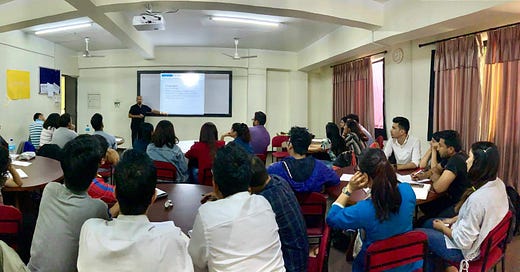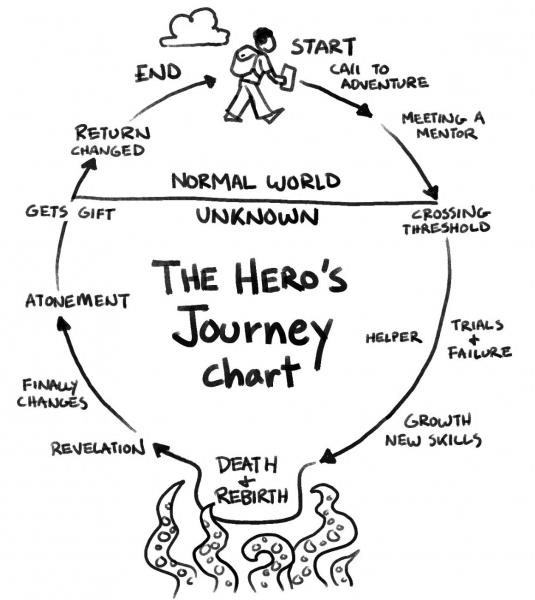Heraclitus once said, you can not step twice in the same river. Because the river is not the same river anymore. And, you are not the same person either.
These Greek philosophers had some way with words.
What he missed was this. Even though the river is not the same river, the water is.
If Heraclitus heard this, he would be pissed at me. Forgive me for unphilosophizing your quote.
Me and my colleagues were having a pointless conversation one day. We realized that we were massively hungry. And as usual I said, “la, let’s go eat momo.”
And, one of the guys said, “Momo? Today as well? We’ve been eating the same thing almost every day.”
“But”, I asked him, “have we? Yes we have been eating momo everyday, but not the same momo.”
My Heraclitus moment. We eat different momo, but we eat the same momo everyday.
Ok, let me stop my rambling and come to the point.
Every Class is a Different Class:
We don’t teach the same class because we teach different students with different experiences, abilities, beliefs, values, opinions, attitudes, and so on. They keep changing every day, every semester, every year.
To refer to Dylan Wiliam, that’s why teaching is so damn interesting. As a teacher, you get to interact with these unique students with unique thoughts and backgrounds.
BUT we do teach the same class everyday.
They might have different faces, different experiences, abilities, beliefs, values, opinions, attitudes, and so on. They still learn in a similar way.
To refer to Dylan Wiliam again, that’s why teaching is possible. Just imagine, if every student that walked into the class learned in their own unique way, there would be no point of teaching them.
Their preferences might be different. Their background might be different. Their interests might be different. But their brain works in a pretty similar way.
Learning is the Residue of Thinking
Here’s my tweak on Dan Willingham’s famous statement, “Memory is the residue of thoughts.”
To learn, the students will have to “think”. Not just think, but think “harder”.1
To demonstrate that they have learned, they will have to apply their learning. To prove that their learning was successful, they will have to use their learning in a new context, to solve problems out there in the world.
It does not really matter whether a student thinks he is a visual learner, or another student thinks she is an emotional learner.
It does not really matter whether a student thinks that learning should be fun, motivating, or interesting.
It does not matter whether a student has used a colorful chart paper, played with science kits, or explored a challenging issue.
At the end of the day, I want the student to think harder. When I ask the student a question, I want see that the student is able to demonstrate the learning by thinking and doing something. I want to see if the student can think in abstraction.
I want to see the proof that you have internalized the learning, automatized the skills, and that you can retrieve your learnings when you need them. That you are now able to sustain the knowledge and skills for a longer time, and connect the dots to other ideas that already exists. That you can add, build, and challenge. That you can abstract.
Every Class is the Same Class
So, even before I walk into a class, I have seen the class a 100 times in my mind. I have the abstraction. The students are different, but they learn in a similar way.
There’s this concept that:
Every story is a different story, but every story is the same story retold in a different way.
Hat tip to Joseph Campbells2, the one who came up with the idea of the “Hero’s Journey”.
Think about learning as a journey, where a student has to go through the known world to the unknown, overcome a challenge, and come back with a new understanding of the world. Every student is a different character. But every learning journey is the similar journey.
Imagine you are a swimming instructor. It does not matter who the learners are. They all have to learn in a similar way. Imagine chess. Imagine chemistry. Imagine writing.
As a teacher, the guru in the Campbell’s story circle, I have seen thousands of such characters going through thousands of such learning journey. It’s exciting. It’s chaotic. And, it’s orderly at the same time.
I would not want to do my job if it was not exciting. And I would not be able to do my job if it was’t orderly.
So trust me, when I tell you, every class is different, and still every class is the same.
Check out Joseph Campbell’s two books, The Hero with a Thousand Face and The Hero’s Journey. If you haven’t, well what have you been waiting for !






Umesh sir, your ideas are so deep and strong, and the examples you set are powerful. I love reading the argument you make in your posts. Thank you for sharing them.